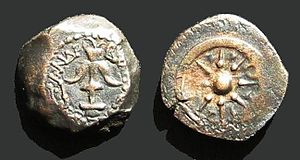Wicked Priest
Most notably the "Groningen Hypothesis" advanced by García Martinez and van der Woude, argues for a series of six Wicked Priests.
He robbed and amassed the riches of men of violence who rebelled against God, and he took the wealth of the peoples, heaping sinful iniquity upon himself.
And he lived in the ways of abominations amidst every unclean defilement.Because of the blood of men and the violence done to the land, to the city, and all its inhabitants.Interpreted, this concerns the Wicked Priest whom God delivered into the hands of his enemies because of the iniquity committed against the Teacher of Righteousness and the men of his Council, that he might be humbled by means of a destroying scourge, in bitterness of soul, because he had done wickedly to His elect.Woe to him who causes his neighbours to drink; who pours out his venom to make them drunk that he may gaze upon their feasts.Interpreted, this concerns the Wicked Priest who pursued the Teacher of Righteousness to the house of his exile that he might confuse him with his venomous fury.
[21] The Nahum Commentary (4Q169) contains numerous explicit references to historical figures, including Alexander Jannaeus, the "furious young lion" who takes revenge on the "seekers of smooth things" for inviting "Demetrius" to conquer Jerusalem.
[27] The best evidence for distinguishing between the two figures is that the Liar is always associated with "false doctrine and the act of misleading" whereas the Wicked Priest is associated with "cultic transgressions and non-observance.
[29] Since the time of de Vaux, the default assumption has been that the Wicked Priest is a single individual, if only because of the appealing parallelism to the Teacher of Righteousness.
[30] The consensus time period for the founding of Qumran (150–140 BCE) includes five High Priests: three Hellenized and two Maccabean: Jason, Menelaus, Alcimus, Jonathan, and Simon, and also the various figures potentially associated with the intersacerdotium.
[36] Similarly, post-Hasmonean High Priests have not received much serious attention because the "Kittim" (identifiable as the Romans due to the distinct practice of "sacrifice to their standards" attested to in 1QpHab 6.6) are referred to in the imperfect[37] and none of the characters associated with the beginning of the Qumran community would have come into contact with the Romans[38] The "Maccabean theory"—as advanced by Cross,[39] Milik,[40] and Vermes[41]—traditionally identifies the Wicked Priest as either Jonathan or Simon.
The most popularly accepted piece of evidence for the identification of Jonathan is his "death at the hands of the Gentiles,"[54] a characteristic shared only by Menelaus (172–162 BCE), who is generally chronologically excluded.
[64] 1 Maccabees 13 recounts the capture and execution of Jonathan at Bascama (in modern Jordan) by Diodotus Tryphon, the general of Seleucid King Alexander Balas, which some have attempted to fit with this incident.
"[67] The so-called "King Jonathan Fragment" (4Q448) has been used both to argue against his identification[68] or for it by connecting it to the Wicked Priest to having been originally "called by the name of truth.
"[69] Alexander Jannaeus died, according to Josephus, of quartan fever and alcoholism, which has been compared to the references to "disease" and "drunkenness" of the Wicked Priest.
[51] Jannaeus also may lay claim to the "delivered into the hands of his enemies" passage because, according to Jewish Antiquities (13:13.5), he succumbed to an ambush by "Obedas, the King of the Arabs" before escaping to Jerusalem.
[70] The Wicked Priests pursuit of the Teacher of Righteousness to the "house of his exile" (1QpHab 11.6) on the "Day of Atonement" (11.7–8) has also been compared to Jannaeus’s known attack on the Pharisees on the Feast of Tabernacles.
[76] The "Groningen hypothesis" advanced by Florentino García Martinez,[77] later together with A.S. van der Woude,[78] interprets columns 8 to 12 of 1QpHab as describing six Wicked Priests in chronological (but not absolute, sequential order as Aristobulus I is excluded).
[79] The six "Groningen" High Priests are: Judas Maccabeus (8.8–13), Alcimus (8.16–9.2), Jonathan (9.9–12), Simon (9.16–10.5), John Hyrcanus I (11.4–8), and Alexander Jannaeus (11.12–12.10).
[85] John Hyrcanus I is assigned the role of the "fifth" Wicked Priest—the one who pursues the Teacher of Righteousness to his house of exile—merely because it fits the preconceived sequence and in the absence of any documentary evidence.



Obv: Seleucid anchor and Greek Legend: BASILEOS ALEXANDROU "King Alexander".
Rev: Eight-spoke wheel or star within diadem. Hebrew legend inside the spokes: "Yehonatan the King".